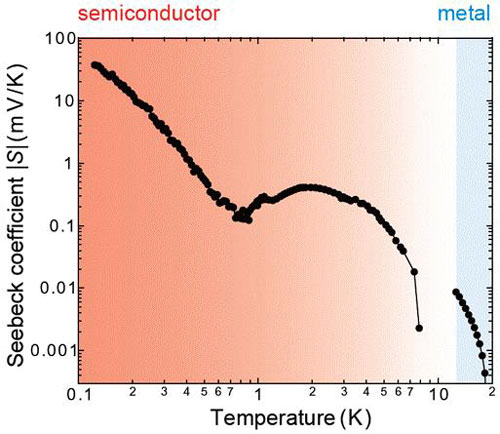| Posted: Jun 27, 2016 |
Discovery of large thermoelectric effect in organic compound at near-zero temperature
(Nanowerk News) Researchers centered at Tokyo Tech experimentally discovered that an organic compound can exhibit the large thermoelectric effect when it becomes semiconducting materials at extremely low temperature (Physical Review Letters, "Colossal Seebeck Coefficient of Hopping Electrons in (TMTSF)2PF6").
|
|
The thermoelectric effect is the direct conversion of temperature difference to electric voltage. The effect is known as the Seebeck effect and is measured by a Seebeck coefficient (volts per difference in temperature). The use of materials with a high Seebeck coefficient is one of many important factors for the efficient behavior of thermoelectric generators and thermoelectric coolers.
|
 |
| Temperature dependence of the magnitude of the Seebeck coefficient |S| for the organic semiconductor (TMTSF)2PF6, which undergoes a metal—semiconductor transition at 12 K (-261.15°C). The Seebeck coefficient |S| shows a remarkable increase at low temperatures, and attains a huge value of ~37 mV/K at around 0.1 K (-273.05°C).
|
|
It had been widely believed that thermoelectric effect of semiconducting materials disappeared at absolute zero. The discovery disproves this past theory and will lead to the development of new materials that show the large thermoelectric effect.
|
|
The researchers measured the electrical resistance and Seebeck coefficient of the organic compound di(2,3,6,7-tetramethyl-1,4,5,8-tetraselenafulvalenium)hexafluorophosphate (TMTSF)2PF6, which turns from metal to semiconducting materials at 12 K. They found that this compound exhibited an extremely high Seebeck coefficient below 1 K. To interpret this value, they investigated how the electrons acting as entropy carriers — a measure of the thermal energy distribution in a material — behave in this material. The mechanism behind the high observed Seebeck coefficient was attributed to variable range hopping, which involves a low concentration of electrons hopping from one trap site to another trap site within the material.
|
|
"As we lowered the temperature below 1 K, the Seebeck coefficient of the material increased dramatically to as high as 37 mV/K," lead author Yo Machida explains. "This is the first experimental confirmation of a finite Seebeck coefficient in a solid at low temperatures."
|
|
The experimental findings support a prediction that hopping electrons in semiconducting materials can generate a sizable Seebeck coefficient at near absolute zero in the presence of Coulomb interaction.
|
|
This study advances understanding of the thermoelectricity of semiconducting materials at near-zero temperature.
|

